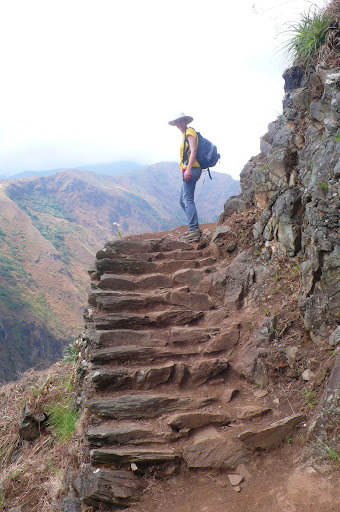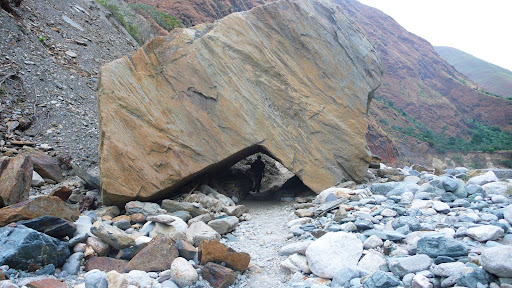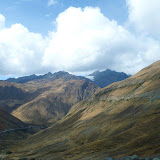Originally, I planned for an extra week in Peru to do said trekking and travelling; however, it turned out that Peruvians take several days off of work for their Independence Day. Thus, the extra week. I flew from Lima to Cusco (the ancient capitol of the Incan Empire) on July 29th and returned yesterday (August 8th). From August 3rd to the 7th, my roommate, Annie, and I trekked from Cusco to Machupicchu with a trekking agency (and 9 other tourists).
Cusco is almost 4,000 meters above sea level (over 13,000 feet or 2.5 miles). Por eso, many tourists get altitude sickness or "soroche." Unfortunately, I came down with a particularly annoying case. I don't have any fact to support my suppositions, but I imagine that when you arrive at high altitudes the pressure inside your body is greater than the pressure outside. So, it feels as if you are expanding. Your sinuses act up, you have a headache, nausea, aching, weakness, and vertigo. Not pleasant. I was only in bed for the first day. The three days after I felt a bit "off" but moved around all the same.
Cusco, Peru
Cusco was the Incan capitol in the 1500s when the Spaniards arrived and claimed the city as their own. Therefore, the city is very colonial with European cobblestone streets and towering cathedrals.

These cathedrals are in the main square and were constructed in the 16th and 17th Centuries.


Cuy and cerdo...guinea pig and roasted pig...big favorites in the Andes region.

The top picture is me with a can of oxygen. There is a lot less oxygen in Cusco which was difficult for me. I carried this thing around with me for about four days.
Saqusawaman
On July 30th, I hiked up to a set of ruins high above Cusco. These ruins were once an impressive Incan military fortress. Manco Inca, the last Incan ruler, fought the Spaniards from this point in an epic and history-altering battle. Obviously, the Incans lost.


Later the Spaniards took several of the stones from this fortress to build their cathedrals in Cusco's Plaza de Armas.

Pisaq
Annie and I took one full day to hike up to the ruins at Pisaq. The village of Pisaq is about an hour and a half outside of Cusco. High above the pueblo sits an extensive system of ruins that took about 5 hours to explore. It constituted another Incan fortress. The Spaniards did not do much with this particular site, because it is so difficult to get to. We hiked for a good hour and a half panting our way to the top.

The hike was straight up!

However, definetly worth the effort.

The hike was just gorgeous!

But we were exhausted once we got to the top.
White Water Rafting on the Urubamba River (sacred river of the Incas)
Another full day trip was our white water rafting adventure. Annie and I booked a tour with an agency and spent a very cold but very thrilling two hours braving level 3 rapids.

We had to wear wet suits, windbreakers, life jackets, and helmets.

Trekking
Annie and I signed up for a 4 day hiking excursion from Cusco to Machupicchu.
Day 1: We began by biking for 4 hours from 4,000 meters above sea level to 1,200 meters. We began the trip at almost freezing temperatures. We ended in the selva alta (high jungle). By the end we were down to our last layers and swatting at thousands of mosquitos (I have about 30 bug bits on my hands and arms).


Day 2: Beginning at 7:30 am, we trekked through the mountains, the valleys, and the jungle for 9 hours. In that span of time, I felt as if I had visited the landscapes of Arkansas, Montana, Colorado, North Carolina, and Hawaii. Our guide said that Peru is home to 80 different types of climates.


Our guides painted our faces with the fruits of a typical plant found in la selva alta (high jungle).

We stopped at a rest area to play with a monkey and get some water.

We emerged from the jungle and hiked to the top of a nearby mountain.


This was part of our trail.

At the end of the day, we rested in a natural hot spring before going to bed.
Day 3: Hiked for about 6 hours to Aguas Calientes, the tourist watering hole at the bottom of Machupicchu.





We crossed the river via a "cable car" or a basket suspended above the water and rope to pull yourself along.
We slept in Aguas Calientes, a small town at the base of Machupicchu mountain that hosts 2,000 tourists a day (in comparison to the 800 actual residents).
Day 4: MACHUPICCHU!
We got up at 3:30 am to hike up Machupicchu mountain. It was pitch black. Our group of 11 along with almost 400 other people trekked up the side of the mountain in a dense line. The trek was straight up a set of original Incan stairs. An hour after beginning, we arrived at the top drenched with sweat.

And this is what sat at the top! After a 2 and a half hour tour, Annie and I hiked all over those mountain tops. We spent about seven hours hiking in and around the "lost city of the Incas." We visited the Sun Gate ("intipunku" in Quechua) about 45 up the mountain behind the city and an ancient Incan bridge built into the side of Machupicchu mountain. The ruins of Machupicchu are perfectly preserved, because the Spanish never found the city (due to it's geographically impossible location). Historians hypothesize that the city was used to house "Virgins of the Sun," women who spent their entire lives serving the sun god (unless they had the great honor to be sacrificed).*



The Sun Gate.

The Incan Bridge.
On August 7th, we took a train/bus from Aguas Calientes back to Cusco.
I wish I could convey the absolute wonder of the Andean region and everything that I saw. You can feel the powerful force of nature all around you. The mountains rise high above you on all sides making you feel vulnerable and protected all at once. The Andean people believe that there are "apus" or gods in the mountains. I can certainly see why. From the animals to the landscape to the people, there is a sense of wonder and spirituality that, I can only imagine, comes from living in such a awe-inspiring place.
As far as the remains of the Incan empire, specifically Machupicchu (one of the seven wonders of the world)...there is nothing like it. It meets the highest expectations. There is nothing like standing above the ancient city, a drop of several thousand feet on your right, a massive 600 year-old wall on your left, and a vista of green mountains topped with glaciers stretching to the horizon. I am so grateful to have had this wonderful experience.
*I took so many pictures of Machupicchu, because every corner holds something wonderful and fascinating. The link below is my picasa album with my many photos.

No comments:
Post a Comment